Garbage
A large white garbage truck parks next to a 20-foot-high mountain of trash in the South Bronx. The truck's rear hatch opens, and ten tons of waste pours out -- a heap of black plastic bags, brightly colored crushed toys, pieces of furniture.
This is Harlem River Yard, one of some 100 "transfer stations" in the city where some 1,100 such trucks deliver 11,000 tons of waste generated by residents, public agencies and non-profit corporations every day. Getting rid of it costs the city almost $3 million a day, nearly a 40 percent increase from five years ago. Private carters handle the garbage generated by businesses, including restaurants -- another 13,000 or so tons per day.
For years, city officials have wrestled with what to do with all of this trash. In the 1940s, the city opened Fresh Kills landfill on Staten Island. Even thought Fresh Kills was supposed to be only temporary, most garbage went there for 53 years. But in May 1996, Governor George Pataki, Mayor Rudolph Giuliani and Staten Island Borough President Guy Molinari announced a plan to close Fresh Kills.
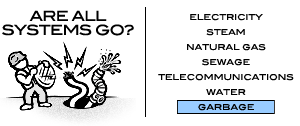 Other articles in this series:
|
The Giuliani administration then proposed placing the garbage on barges and shipping it to Linden, New Jersey. From there, it would have been loaded on trains and shipped to out-of-state landfills. But the plan was sidelined by charges of corruption in Linden.
Since then the city has struggled, without much success to find an economical, environmentally sound alternative.
Today, city sanitation trucks take most garbage to one of the privately owned transfer stations such as the one in the South Bronx. There, inside a 60,000 square-foot warehouse, compacters -- heavy machines that resemble bulldozers -- ride over the garbage so that it takes up less room. As these machines work, mist drifts from the ceiling to keep the dust level down.
More than half the city's transfer stations are concentrated in a few low-income areas, such as Red Hook, Greenpoint, Williamsburg and Sunset Park in Brooklyn; Hunter's Point and South Jamaica in Queens; and the South Bronx. Truck traffic clogs the streets in those communities, and residents complain of pollution from diesel exhaust.
"These land-based transfer stations are poorly regulated," said Ramon Cruz of Environmental Defense, a non-profit organization. "And they are very close to residential areas where poor people and people of color live. This is the environmental justice issue within the city."
More than half the garbage processed in the Bronx -- some 3,300 tons -- comes from other boroughs, according to Jaime Rivera, director of South Bronx Clean Air Coalition. "We are not going to take it any more, not even one more pound," he said.
To reduce truck traffic and better distribute the transfer stations, Mayor Michael Bloomberg last year proposed hauling the trash to marine-transfer stations in each borough. These facilities used to load refuse on barges for shipment to Fresh Kills. In the post-Fresh Kills era, the garbage would be put in containers, placed on barges and later sent by ship or train to its final destination. But earlier this year, a Sanitation Department deputy commissioner told the City Council that opening the marine-transfer stations would cost about $400 million, much more than the original estimate of $240 million. The department also now says that rebuilding the transfer stations will take far longer that had been anticipated.
Despite all this, Bloomberg says he has not abandoned that idea. But earlier this month he admitted little progress had been made on his plan. And administration officials said they were seeking alternatives. A consultant will review a variety of schemes, the New York Times reports, including sending the trash to the Caribbean or using a new technology that burns the trash at an exceedingly high temperature to convert it into natural gas and a stone-like material.
Most environmentalists had supported the plan for using marine-transfer stations. “We think it is environmentally better because you are less dependant on heavy-duty trucks with diesel engines,” said Cruz at Environmental Defense. “Reopening of the marine system or rail, or a combination of both, would be much better [than the current system]. ”
For now, however, the city still depends on facilities such as the Harlem River Yard. There, heavy machines called wheel loaders push the compacted trash toward rail cars. Machines called grapples pick up the garbage and drop it into rail cars. Every day, a train of about 35 of these rail cars leaves the Harlem Yard, packed with garbage and heading to a landfill in Waverly, Virginia, about 400 miles away. Waste Management owns and operates the landfill, as well as four other transfer facilities in the city. Except for Harlem Yard, all the transfer stations ship waste by truck.
Of all the city trash, about 19 percent ends up being burned in incinerators that produce energy. The rest is destined for landfills, virtually all of them out of state. The private owner of the transfer station -- not the city -- decides where the garbage will go and pays the costs for shipping it there.
Fees for getting rid of the garbage -- so-called tipping fees -- rose sharply during the 1980s but have stabilized some since then. And they vary widely -- between $10 to almost $100 a ton -- depending upon the location and the method of disposal. Whatever the fees, the city has no choice but to pay.
New ideas and technologies are coming along, but the basis of solid waste management -- dump or burn -- remains unchanged. The city instituted recycling in the 1990s and then partly suspended the program in 2002 because of its fiscal crisis. This July, the city partly restored recycling, and it is now accepting proposals from private companies to resume a full recycling program next spring.
But this may not be enough, some experts say. "The city needs structural changes for waste management," said Benjamin Miller, author of the book, "Fat of the Land: The Garbage of New York -- The Last Two Hundred Years. "It's absolutely critical to have an overall plan. We cannot just keep on doing things, ad hoc, one step at a time."
Water
New York City's water supply system has been called a marvel of engineering -- the eighth wonder of the world. It covers some 2,000 square miles, runs as deep as 1,100 feet underground and supplies as much as 1.5 billion gallons of water per day to more than nine million people.
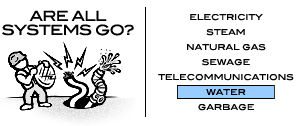 Other articles in this series:
|
But even at the earliest stages of its journey -- as water trickles down the face of the mountains of the Catskills -- the people in charge of New York's water supply worry about its quality. As these trickles gather momentum and join together into streams, the city's scientists are right there serving as monitors, looking for heavy algae growth and other signs of pollution, including microscopic animals that can cause stomach problems and diarrhea.
Before 1842, New York's water supply consisted of a single fetid pool in lower Manhattan, and water-born disease was common.
Now, after the water flows from hundreds of small Catskill Mountain streams and the Delaware River into 19 upstate reservoirs, it is naturally filtered by rocks and soil. Once it reaches the reservoirs, it is allowed to sit for a while. That is so that impurities in the water can settle to the bottom.
From the reservoir, water is discharged into the city's aqueducts. The New York City Department of Environmental Protection must check the aging upstate aqueducts for leaks. In June, the city sent an unmanned submarine to inspect a damaged 45-mile stretch of the Delaware Aqueduct. Results from the submarine's 16-hour photographic journey are still being studied, but according to officials, the aqueduct has at least two known leaks that spill as much as 36 million gallons of water a day.
The water that does get through then enters the city distribution system. Most cities filter their water at this stage of the process. But New York does not.
"The water that comes into New York City aqueducts is frequently of superior quality than filtered systems, but it also makes it very fragile," said Jim Tierney, the city official in charge of protecting the reservoirs and the region surrounding it, known as the watershed. "It makes protective efforts to keep pollutants out of the water all the more important."
With that in mind, in 1997, city, state and federal agencies and environmental groups reached an agreement designed to protect New York's watershed, which, though comprising just a fraction of the state's total land area, supplies water to half the state's population. "If there's anything you have to protect in New York," Tierney said, "it's this watershed."
The U.S. Environmental Protection Agency has waived the requirement that the city filter much of its water. But the city did not apply for a waiver for water coming from the Croton watershed and must now build a filtration plant. The city is currently reviewing three potential sites for the plant, one in Westchester and two in the Bronx. The plant must be operating by 2010 or 2011, depending on which site is chosen.
New York does treat its water though. Chlorine is added to kill organisms such as Giardia, which can cause diarrhea in humans. At each stage of the journey from here on, chlorine levels will be carefully calibrated and monitored, to make sure there is enough chlorine to kill bacteria and parasites -- but not so much that it makes the water disagreeable.
One part of fluoride per million parts of water goes in to help New Yorkers fight tooth cavities. The city adds orthophosphate to keep lead from leaching into the water, while some of the city’s water also gets a dose of sodium hydroxide to make it less corrosive.
Once water is treated, it enters City Tunnels No. 1 and 2, the main distribution tunnels. Pressure in the tunnels forces water up vertical shafts and into the city's water mains.
If there is a leak in either of these tunnels, there is little the city can do. Sandhogs are digging a 60-mile-long third water tunnel, but construction is not scheduled to be completed until 2020. Until then, engineers cannot shut down the city's two existing tunnels for repair.
"A disaster could happen at any moment, a disaster of epic proportions, or they will get the tunnel built in time. Nobody knows," said Jeff Jones of Environmental Advocates.
From the tunnels, the water branches out into the city’s water pipes. Some of these were first put into service in the 1800s, and as residents of Washington Heights discovered recently, they can burst, shooting geysers 20 feet into the air, turning streets into lakes, flooding basements and leaving hundreds of thousands of dollars of damage in their wake. New York City experiences 600 breaks per year on average, according to the Department of Environmental Protection. Even minor ones can sully the water supply and cause disruptions.
Before the water enters individual homes and buildings, it is tested again at one of the nearly 1,000 sampling stations throughout the city. Tony Speranza is one of 16 Department of Environmental Protection field collectors charged with monitoring water quality to ensure it meets federal and state guidelines. On a recent morning, Speranza's route took him to the corner of Maiden Lane and (aptly) Water Street. Inside an inconspicuous metal box resembling an oversized parking meter was a simple faucet and miniature basin.
First, Speranza disinfected and flushed the tap. Then, he pulled a milk crate filled with specimen containers -- each one labeled and bar-coded -- from the truck that doubles as his roving laboratory. As water gushed into the basin, Speranza checked for telltale signs of contamination.
According to Speranza, even small variances in temperature or conductivity (a measure of metals in the water) can indicate a problem in the system. And curbside sampling is especially important when it comes to monitoring chlorine.
From here, water is carried by service pipes to individual buildings -- and finally to residents' faucets. Officials will check some of this water as well, testing for lead levels. This final point marks the end of an extraordinary journey, one that is powered entirely by gravity.
If there are problems, as people like Speranza certainly know there are, still, as far as he is concerned, "New York City water is the best in the world."
The New York Stock Exchange And Wall Street's Future
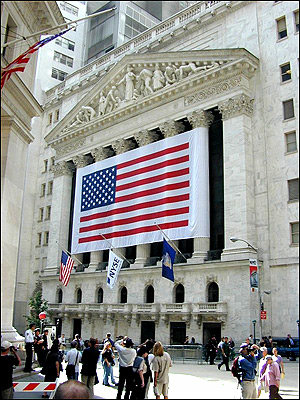 Outside the New York Stock Exchange Outside the New York Stock Exchange |
When the mayor and the governor held a press conference last week at the New York Stock Exchange, they promised a “bold vision” for a “new financial district.” At first glance, what they announced seemed neither bold nor even much of a vision. They presented plans to repave some streets outside the exchange, replace temporary concrete barricades with permanent fences and remove the parked pickup trucks that have been serving as makeshift safety barriers at several downtown intersections.
Even the timing of their press conference – the day before Thanksgiving – seemed to be saying: This is no big deal.
Modest as the plans seem, however, they were a welcome holiday gift to the business leaders and merchants of Lower Manhattan. Wall Street has been clamoring for officials to do something about the stifling security measures that have impeded traffic for more than two years; the complaints began while the twin towers were still burning.
If the streets outside the New York Stock Exchange are undergoing cosmetic changes, the changes happening inside the colonnaded marble building at Broad and Wall Streets are the most dramatic since the Great Depression.
After a series of scandals, the exchange in September named a new director, John S. Reed, who has set about trying to restore public confidence by completely restructuring the institution.
But even some of the exchange's biggest customers are questioning its very nature, suggesting that its time-honored trading floor, and the jobs it generates, be replaced with an electronic system similar to that used by fast-growing NASDAQ.
For New York City, the stakes are especially high. By thoroughly restructuring itself, the exchange is attempting to preserve jobs while retaining its primacy among stock markets and its position at the epicenter of the financial services industry. This industry is arguably the most important in New York, one that accounts for a third of the city's economy and a quarter of its tax revenues.
Even without the recent stock market scandals, New York's position as financial capital has been eroding. In the year 2000, the securities industry in New York City employed 189,000 people; a year later, thanks to the economic slowdown, the figure was down to 175,500. In 1991, the city had just over 30 percent of the nation's securities-related jobs. A decade later, thanks to the rise of electronic stock trading, the figure was below 24 percent. And this was before September 11th, 2001.
When the exchange threatened to leave town and move to New Jersey, city and state officials were quick to offer more than a billion dollars to keep it, promising new headquarters across the street from the current location.
The plans for the new exchange were scrapped after 9/11. Perhaps it is a sign of an era of lowered expectations that, instead of the Giuliani-era press conference announcing a billion-dollar subsidy, the one last week touted changes to the landscape that would cost a total of just some $10 million, paid for by the Lower Manhattan Development Corporation. In both cases, though, officials were communicating much the same message: Something must be done.
The New York Stock Exchange, says William Freund, its former chief economist, is facing not just temporary turmoil but a future of ever-greater competition. "I'm confident that it is going to prevail as an institution,” says Freund, now director of the Freund Center for the Study of Securities at Pace University. “But increasingly it will be a very tough fight."
CRISES
 Departing New York Stock Exchange chief Dick Grasso, who leaves amid amid revelations of possible trading abuses and conflicts of interest. Departing New York Stock Exchange chief Dick Grasso, who leaves amid amid revelations of possible trading abuses and conflicts of interest. |
The New York Stock Exchange has weathered many crises since 1792, when a group of traders met beneath a buttonwood tree on Wall Street and formed a loose association that grew into the world's most powerful financial market.
Recent times, however, have been especially difficult. The dotcom bust, revelations that star analysts touted questionable stocks to boost their firms' investment banking businesses and the collapse of such high-flyers as Enron, Worldcom and Tyco shook investor confidence and tainted the investment industry.
This summer, scandal hit the exchange itself after revelations that New York Stock Exchange chairman Richard Grasso was awarded a $187.5 million pay package by a board of directors that he essentially controlled. One particularly irksome item was the $5 million bonus Grasso received for getting the exchange up and running after September 11, 2001. Thousands of others on Wall Street worked tirelessly at the time without any extra compensation.
Though Grasso is widely credited with preserving the New York exchange's share of the market for stocks, during his tenure the exchange developed a reputation for being a vast insiders' playground. His departure unleashed revelations of possible trading abuses and conflicts of interest at the exchange and elsewhere in the financial industry, including a series of investigations by New York State Attorney General Elliot Spitzer that further tarnished Wall Street's image.
UNLIKELY RADICAL
To replace Grasso the exchange tapped as interim chairman the 64-year-old Reed, a former Citicorp chairman known for his fascination with organization charts and information systems.
Coming back from the island off the coast of France where he had comfortably retired, Reed got right to work and declared that he would take a hands-on approach. He set about completely revamping the exchange, making its operations more transparent to both investors and regulators.
"I am a revolutionary," Reed told London's Financial Times in a November 13 interview, his first after taking over.
Reed proposed sweeping changes in the way the exchange is governed. In place of its 27-member board, he called for creating two panels. An eight-member board intended to be independent of the exchanges' management would be responsible for governance and regulation. A second "board of executives," with 20 members drawn from Wall Street firms, specialists and others in the securities industry, would oversee day-to-day operations.
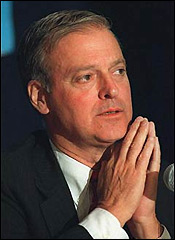 "I am a revolutionary," John Reed told London's Financial Times. "I am a revolutionary," John Reed told London's Financial Times. |
Reed's plan was approved by the exchange in mid-November, but the Securities and Exchange Commission still has to give its approval. So far, reaction is lukewarm.
The commission's new head, William Donaldson, favors replacing the exchange's self-regulatory apparatus with a totally separate, independent system. New York State Comptroller Alan Hevesi, who controls pension funds and is involved in a nationwide coalition aimed at reforming corporate governance, said he too was "disappointed"with the exchange's plan.
Still, the efforts are radical for an institution that has been resistant to change. "If the New York Stock Exchange gets reformed, which I think is a pretty good bet right now, this is on a par with the reforms of 1933 and 1934," Charles R. Geisst, a Wall Street historian and professor at Manhattan College in the Bronx, told The Washington Post recently.
And however the governance issue plays out, an even more sweeping change may soon alter the open auction system that has been central to the New York Stock Exchange's trading system for decades.
Like many self-styled reformers, Reed may find that his revolution overtakes him and acquires a life of its own. With the iron-willed Grasso gone, old discontents are bubbling to the surface, threatening to touch off a new battle over the structure of the exchange and the very shape of U.S. financial markets.
Lately, some of the exchange's biggest customers, among them giant mutual funds and government pension funds, are saying out loud what had only been whispered in the past: that it's time to dump the NYSE's "open outcry" trading system, which relies on middlemen called specialists, and move to an electronic system that would mean lower costs for investors and would offer fewer opportunities for corruption.
This would mean the end of the exchange's famous trading floor, with its frenzied auctions and piles of discarded order slips.
AN ENTERTAINING ANACHRONISM
In an age of microchips, the New York Stock Exchange trading floor is an entertaining anachronism.
At the exchange, when an order comes in, either by phone or electronically, it is sent to one of some 430 specialists, who handles all of the trading for that stock and several others. These specialists are the people in the colored jackets who can be seen striding around or waving bits of paper in TV news shots of the trading floor.
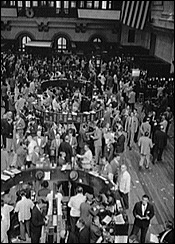 The trading floor of the New York Stock Exchange, 1955. The trading floor of the New York Stock Exchange, 1955. |
Each specialist, who is stationed at a booth on the floor of the exchange, essentially conducts an auction of his stocks, matching buyers and sellers or dipping into his own company's holdings to make sure there are enough shares available.
Once buyers and sellers are matched, the specialist reports the results of the transaction and the information is sent out to quote systems so that others know the stock's most recent trading price.
On electronic exchanges like Nasdaq, computers scan all the orders and match up buyers and sellers at the best available price.
The New York Stock Exchange's human-based trading system is, of course, supported by a vast network of electronics. Thanks to computers and productivity gains, it now trades an average of 1.5 billion shares a day; just a couple of decades ago it handled a couple of hundred million.
Critics say that computers are more efficient and far less likely to bend the rules for their own gain.
Because the New York Stock Exchange's specialists, unlike all other traders, have knowledge of all the bids and asking prices on a stock, they can gauge the direction of share prices before anybody else. Stock market officials say this allows them to maintain a fair and orderly market by stepping in and bringing sellers and buyers closer together. But critics charge that the specialists are perfectly positioned to fleece other traders.
"In the biggest, deepest market on the planet, I don't understand why there has to be someone who has advantage over everyone else" Scott DeSano, head of global equity trading at Fidelity, told USA Today. "All we're trying to promote are free, competitive markets."
Others point out that some of the large mutual funds that are criticizing the specialist system own stakes in fledgling electronic stock trading outfits that would like to siphon business away from the New York Stock Exchange.
The New York Stock Exchange is determined to defend its long-established ways.
"The specialist system works and it works very well," NYSE spokesman Rich Adamonis said.
WILL 'WALL STREET' STAY ON WALL STREET?
Amid all the uncertainty surrounding the stock exchange, one thing is clear:the New York Stock Exchange will stay in its columned 1901 edifice -- at least, for the moment.
A couple of years ago, it seemed virtually certain that the exchange would move to a new building across the street. In the biggest of all the Giuliani-era business retention deals, the city and the state agreed to shell out as much as $1.1 billion over a number of years to keep the New York Stock Exchange from carrying out its threat to leave for New Jersey. As part of the package, the city agreed to buy land for the exchange's new trading floor. A residential building on Wall Street was even emptied in anticipation of the project.
But the deal was put on hold after the September 11 attacks, and eventually the exchange, after rethinking the wisdom of building a conspicuous new headquarters, pulled out entirely. The city had already spent some $80 million.
So will Wall Street stay forever on Wall Street? The exchange now has an auxiliary facility in Brooklyn, at the Metrotech Center, in case of further disaster in Lower Manhattan, and another such facility at undisclosed location in the city. It is considering other sites in the suburbs.




